Contents
- 20 Indian Army soldiers killed in Chinese clash: Galwan
- Massive fall in advance tax mop-up
- Respond to disqualification plea: SC to Goa speaker
- Nod to NHAI’s ₹50K Cr SPV
- China dumping key medicine in India
- NTPC plans a greener option to power A&N
- Guwahati redefines concept of urban jungle
20 INDIAN ARMY SOLDIERS KILLED IN CHINESE CLASH: GALWAN
Focus: GS-II International Relations
Why in news?
- Twenty Indian personnel, including a Colonel, were killed in violent clashes with Chinese troops along the Line of Actual Control (LAC) in Ladakh.
Details of claims
- The Chinese People’s Liberation Army (PLA) accused India “of going back on its word” and “violating commitments” reached by both sides at Corps Commander-level talks.
- China Claims that the sovereignty of the Galwan Valley region has always belonged to China, something India has always contested.
- Indian Ministry of External Affairs said “the Chinese side departed from the consensus to respect the Line of Actual Control (LAC) in the Galwan Valley.” With China trying to “unilaterally change the status quo”, both sides “suffered casualties that could have been avoided” had China stuck to what had been agreed.
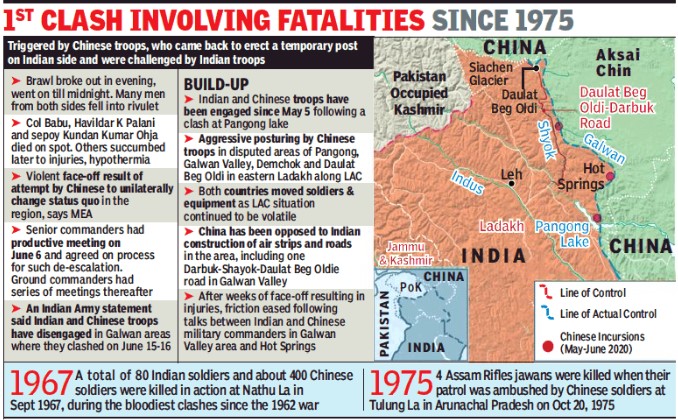
Background to the Current situation
- The standoff had begun with a scuffle in the Pangong Tso area on the intervening night of May 5/6, resulting in serious injuries on both sides.
- The two sides were engaged in discussions to pull back troops, amassed over weeks.
- The cause for this was China objecting to a road that India was building on the banks of the Pangong Tso Lake in Ladakh.
- This is the first time in 45 years that the neighbouring countries have shed blood, however, there was no firing during the face-off.
- Therefore, there have been no firings on the India China border since 1975.
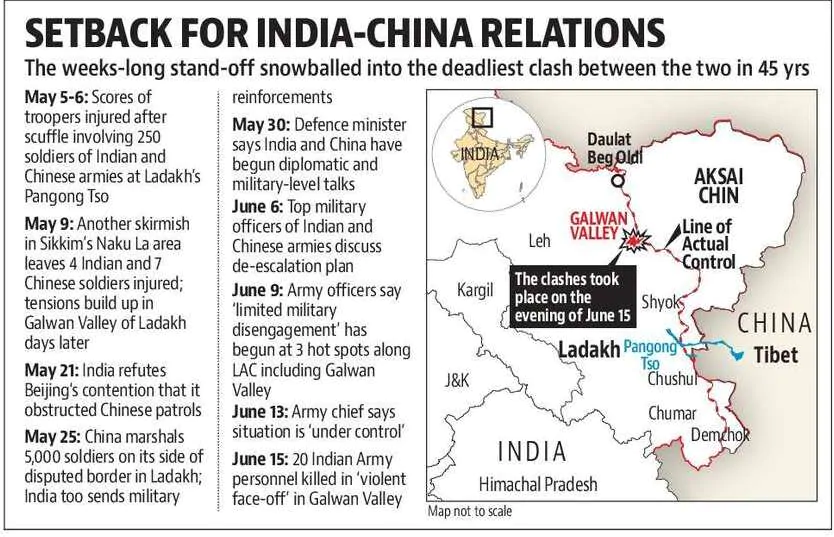
Click Here to read about the Indi-China stand off
Significance of Galwan Valley Region
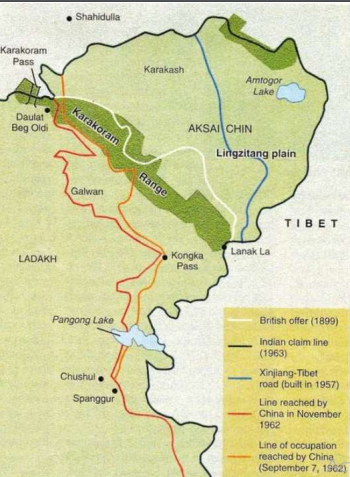
- The Galwan River flows from the Aksai Chin region to Ladakh of India and is one of the upstream tributaries of the Indus River.
- The Galwan river is to the west of China’s 1956 claim line and in the Indian side of the border in Aksai Chin.
- However, in 1960 China advanced its claim line to the west of the river along the mountain ridge adjoining the Shyok river valley. India continues to claim the entire Aksai Chin plateau.
- The Galwan river is the highest ridgeline and it allows the Chinese to dominate the Shyok route passes, which is close to the river.
- Chinese are keen on controlling this area as they fear that the Indian side could end up threatening their position on the Aksai Chin plateau by using the river valley.
- Based on satellite imagery, the Chinese had built a road until the middle point of the Galwan valley by 2016. And since then, they have managed to extend this to some point closer to the LAC in the sector.
- The Chinese build-up along the Galwan River valley region overlooks, and hence poses a direct threat to the Darbuk-Shyokh-Daulat Beg Oldie (DSDBO) road.
Click Here to read more about the DSDBO road and strategic importance (3rd Article)
Click Here to read more about the History of the LAC (2nd Article)
Impact on India – China Trade
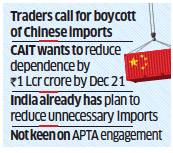
- India’s border tensions with China may not have an immediate impact on business and trade relations.
- China had a surplus of more than 45 $ billion in trade with India in the first 11 months of FY20.
- Small retailers have called for a boycott of goods made in China and the promotion of local products instead to reduce this gap.
- Key imports from China were electronics, organic chemicals and machinery.
- New Delhi has not been keen to continue its engagement with China in the Asia Pacific Trade Agreement or APTA the only operational trade pact linking India and China.
- China was a key factor behind India’s exit from negotiations on the Regional Comprehensive Economic Partnership (RCEP) trade agreement in 2019 as it feared further opening up of trade with the country would dramatically increase the trade deficit.
-Source: The Hindu, Economic Times
MASSIVE FALL IN ADVANCE TAX MOP-UP
Focus: GS-III Indian Economy
Why in news?
Gross tax collections were estimated to be over 30% lower till mid-June on the back of a sharp decline in advance tax payments, indicating a severe impact on businesses due to the coronavirus-induced lockdown.
Details and Impact
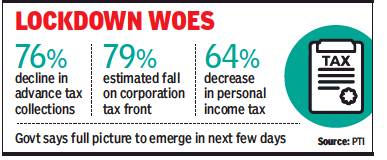
- The overall trend is a decline in earnings during the first quarter, led by the disruption in economic activity, following the nationwide lockdown.
- Several large taxpayers such as oil companies will face pressure due to the large inventory of crude that they purchased at higher prices, but have been unable to unload due to a decline in demand.
- Although banks are expected to buck the trend in the first quarter, going forward they are seen to be vulnerable, given that asset quality pressures typically set in after a few quarters.
- The tax numbers will also prompt the finance ministry to once again recalibrate its spending, with further belttightening expected as the Centre seeks to put a check on non-essential spending.
-Source: Times of India
RESPOND TO DISQUALIFICATION PLEA: SC TO GOA SPEAKER
Focus: GS-II Governance
Why in news?
- The Supreme Court directed Goa assembly speaker and 10 MLAs to reply within four weeks to a petition filed against them.
- The petition calls out the nearly nine-month delay by the speaker in deciding the disqualification petitions filed against the MLAs.
In the Past:
- There are orders passed seeking direction to restrain the MLAs from attending the assembly proceedings during the pendency of the disqualification petition.
- There is also another SC judgment which provided that disqualification pleas should be decided within three months.
- MLAs continuing to participate as members of the legislative assembly, despite having ex-facie incurred a disqualification under Schedule X of the Constitution of India is an issue that has been seen in the past.
What is Defection (Aaya Ram Gaya Ram)?
- Aaya Ram Gaya Ram (English: Ram has come, Ram has gone) expression in politics of India means the frequent floor-crossing, turncoating, switching parties and political horse trading in the legislature by the elected politicians and political parties.
A legislator is deemed to have defected if:
- If an elected member voluntarily gives up his membership of a political party;
- If he votes or abstains from voting in such House contrary to any direction issued by his political party or anyone authorised to do so, without obtaining prior permission.
As a pre-condition for his disqualification, his abstention from voting should not be condoned by his party or the authorised person within 15 days of such incident.
Anti-Defection Law
- 1985 Anti-defection Act was passed in 1985 to prevent defections.
- It was included in constitution by Rajiv Gandhi government as the tenth schedule of Indian constitution.
- The Anti-defection Act, applicable to both Parliament and state assemblies, specifies the process for the Presiding Officer of a legislature (Speaker) to disqualify a legislator on grounds of defection based on a petition by any other member of the House.
- Legislators can change their party without the risk of disqualification to merge with or into another party provided that at least two-thirds of the legislators are in favour of the merger, neither the members who decide to merge, nor the ones who stay with the original party will face disqualification.
- The Supreme Court mandated that in the absence of a formal resignation, the giving up of membership can be determined by the conduct of a legislator, such as publicly expressing opposition to their party or support for another party, engaging in anti-party activities, criticizing the party on public forums on multiple occasions, and attending rallies organised by opposition parties.
- The Presiding Officer has no time limit to make his decision
-Source: Times of India
NOD TO NHAI’S ₹50K CR SPV
Focus: GS-III Indian Economy, Industry and Infrastructure
Why in news?
The National Highways Authority of India (NHAI) will go ahead with a plan to raise ₹50,000 crore through a special purpose vehicle (SPV) with the National Investment and Infrastructure Fund (NIIF) for the Delhi-Mumbai expressway project.
What Is a Special Purpose Vehicle (SPV)?
A special purpose vehicle, also called a special purpose entity (SPE), is a subsidiary created by a parent company to isolate financial risk. Its legal status as a separate company makes its obligations secure even if the parent company goes bankrupt.
Understanding the SPV
- A parent company creates an SPV to isolate or securitize assets in a separate company that is often kept off the balance sheet.
- It may be created in order to undertake a risky project while protecting the parent company from the most severe risks of its failure.
- In other cases, the SPV may be created solely to securitize debt so that investors can be assured of repayment.
- In any case, the operations of the SPV are limited to the acquisition and financing of specific assets, and the separate company structure serves as a method of isolating the risks of these activities.
Click Here to read more about NHAI (1st Article)
-Source: Economic Times
CHINA DUMPING KEY MEDICINE IN INDIA
Focus: GS-III Indian Economy
Why in news?
The government has found sufficient evidence that China is dumping a key medicine – ciprofloxacin hydrochloride – below cost in the Indian market and hurting the domestic pharmaceutical industry.
Details
- Ciprofloxacin hydrochloride – used to treat bacterial infections, including skin, bone, respiratory and urinary tract infections, and certain types of diarrhoea.
- China alone accounts for about 98% of the total Indian imports of the medicine.
- DGTR (Directorate General of Trade Remedies) provisionally concluded that the domestic industry has suffered material injury and its preliminary findings favoured the imposition of an anti-dumping duty on Chinese import.
Directorate General of Trade Remedies (DGTR)
Directorate General of Trade Remedies (DGTR) is an apex national authority responsible for administering all the trade remedial measures which include:
- Anti-Dumping Duties
- Countervailing Duties and
- Other Safeguard Measures.
Established in 1998 as the Directorate General of Anti-Dumping & Allied Duties, it was renamed in 2018 as the Directorate General of Trade Remedies (DGTR).
- The Directorate General of Anti-dumping and Allied Duties (DGAD), Directorate General of Safeguards (DGS) and Safeguards (QR) functions of DGFT were merged into one single entity, DGTR, making it an integrated single umbrella National Authority.
- DGTR works alongside the Department of Commerce under the Ministry of Commerce and Industry.
- The Department of Revenue considers the recommendations of DGTR for imposing Anti-Dumping, Countervailing and Safeguard Duties.
- Trade defence support would be provided by the DGTR to our domestic industries and the exporters in dealing with the trade remedy investigations instituted by other countries against them.
-Source: Hindustan Times
NTPC PLANS A GREENER OPTION TO POWER A&N
Focus: GS-III Environment and Ecology, Prelims
Why in news?
The Andaman and Nicobar (A&N) islands are set to go green with state-run power generator NTPC Ltd poised to call bids to build a floating micro-liquefied natural gas (LNG) terminal to power the Indian archipelago.
Benefits
- The clean fuel sourced through the Floating Storage Regasification Unit (FSRU) will help generate 50MW at Hope Town, South Andaman, enough to power the islands and replace the current system of generating power from diesel.
- This will not only reduce the carbon footprint by ending the practice of diesel-based power generation, but will also provide a much cheaper source of generating electricity.
- The improved infrastructure will also allow India to secure the strategic advantage the islands offer in the Indian Ocean and protect its trade routes at a time when China is expanding its naval reach.
India and Development of A&N
- India has taken steps for the Expansion of naval air stations.
- India has also taken up building a railway line from the capital of Port Blair to Diglipur on North Island.
- State-run National Highways and Infrastructure Development Corp. Ltd (NHIDCL) is also building bridges and roads in A&N at an investment of around ₹3,000 crore.
- The Centre also plans to establish ship-building and ship-repairing facilities at the islands. It is laying a submarine optical fibre cable between Chennai and Port Blair and five other islands of Havelock, Little Andaman, Car Nicobar, Kamorta and Campbell.
- It also plans to add new ships to the fleet for improving connectivity between the mainland and the islands.
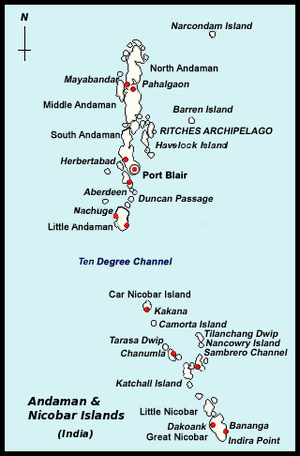
-Source: Livemint
GUWAHATI REDEFINES CONCEPT OF URBAN JUNGLE
Focus: GS-III Environment and Ecology, Prelims
Introduction
- Guwahati, Assam’s capital city and the largest in the northeast, has a 620-hectare Hengerabari Reserve Forest referred to as the city’s lungs.
- Chinese pangolin, Nepal cricket frog, Bengal monitor lizard, Assamese cat snake, Eurasian moorhen, Asian elephant, Terai cricket frog and Ganges river dolphin are amongst the 320+ species of fauna (Very few of them are caged in the Assam State Zoo) that reside in the Hengerabari Reserve Forest.
- The Hengeraberi Reserve forest redefines the term “urban jungle” with more than 320 free-ranging fauna living in the green spaces within concrete structures.
Guwahati and its specialty
- The city of Guwahati is the biggest metropolis in Northeast India and also happens to be a part of Indo-Burma Biodiversity Hotspot.
- Guwahati and its outskirts have eight Reserve Forests (South Kalapahar RF, Fatasil RF, Jalukbari RF, Gotanagar RF, Hengrabari RF, Sarania Hill RF, Garbhanga RF, Rani RF) and two Wildlife Sanctuaries (Deeporbeel WLS and Amchang WLS) along with an internationally acclaimed wetland and Ramsar site, the Deeporbeel, within the city limits.
- This stretch of the river has a few Ganges river dolphin (Guwahati is the only city in India to have its own city’s animal: The Ganges River Dolphin).
- People have co-existed with arguably the widest range of fauna despite human-animal conflicts in the region.
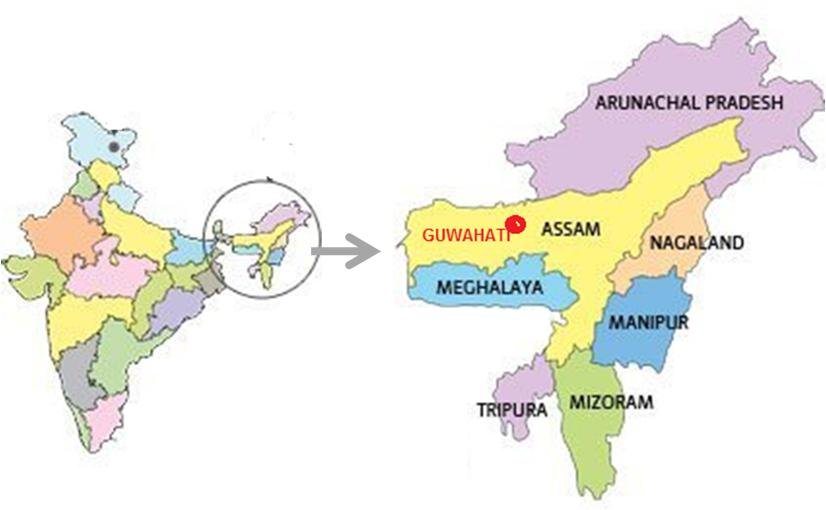
-Source: The Hindu




